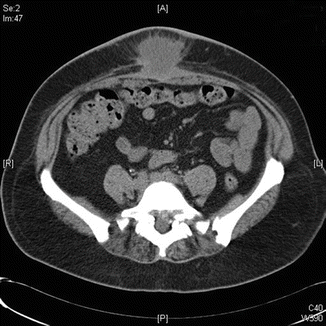Fig. 40.1
(a, b) Initial clinical presentation. Note the inflammatory infraumbilical skin
She had an abdominoplasty 10 years before that was complicated by a postoperative Staphylococcus aureus surgical site infection. It was an abscess of the infraumbilical region with no wound dehiscence that was drained twice. No foreign body was found and the patient healed with the aid of antibiotics. As a result the infraumbilical skin became firmly retracted and very adherent. Her surgeon prescribed several massages but the skin deformation did not change. Until this day she was almost asymptomatic with periods of itching and local soreness. Two years before this consultation, the patient had a laparoscopic gallbladder removal but the infraumbilical region was not concerned by the surgery. Echography did not explore this region either. Itching and soreness though persisted until 5 days before this consultation where she had an accidental kick by a patient while working as a nurse assistant. Soon after this incident the patient started having intense pain in the lower abdominal region that motivated this emergency consultation.
Blood tests were normal and a CT scan showed a subcutaneous liquid collection (Fig. 40.2). The diagnosis of either an infected hematoma or an abscess was made and the patient was operated. Thick pus with no hematoma was drained. Neighboring tissues and muscle fascia were not necrotic and no foreign body was found. Everyday lavages took place so as to obtain a clean wound. Bacteriological analysis identified a Staphylococcus aureus sensible to methicillin, and appropriate antibiotics were given. Tissue histological analysis did not reveal any noninfectious or granulomatous disease. The patient was discharged 5 days after and she healed with no other unfavorable incident.


Fig. 40.2
CT scan findings. Note the supra-fascia collection and soft tissue infiltration
What is intriguing in this case report is that the symptoms, patient history, and even the bacteriological results imply that this incident is related to the initial abdominoplasty. Surgical site infection after abdominoplasty is the second most frequent unwanted event following seromas. Incidence may vary between 3 and 5 % [1, 2] but no other publication describes latent abscesses. The only chronic abscesses that were found were related to granulomatous diseases or osseous-related infections [3, 4]. On the other hand though, the clear definition of a surgical site infection with no implant is the infection that occurs within 30 days after surgery [5




Stay updated, free articles. Join our Telegram channel

Full access? Get Clinical Tree







